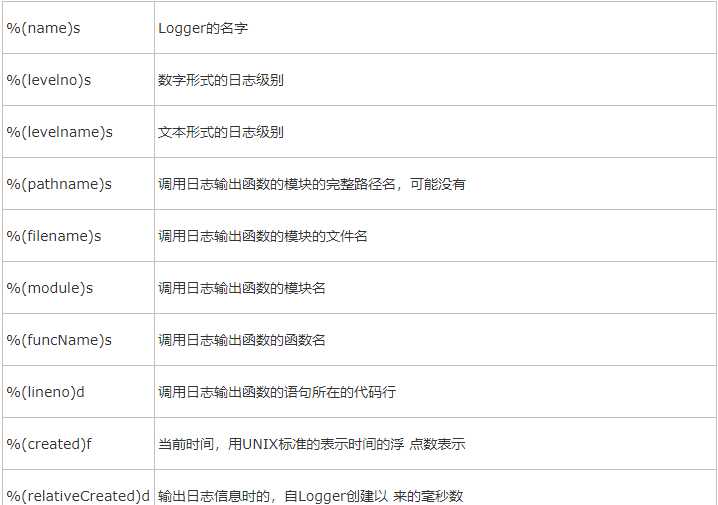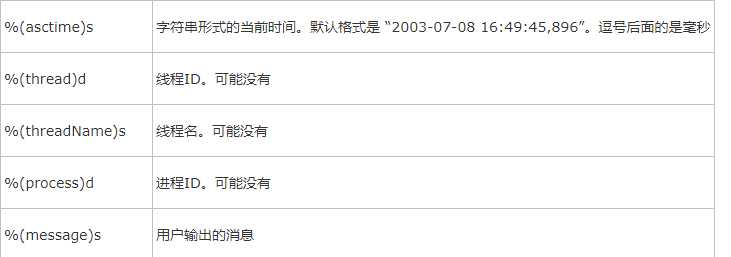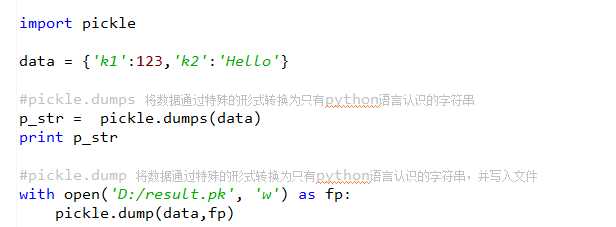标签:class 目录名 https 管道 asi anywhere 当前时间 expired debug
import time print(time.time()) print(time.clock())#计算cpu执行时间 print(time.gmtime())#世界标准时间 print(time.strftime()) #Commonly used format codes: 设置时间第一个参数为设置时间格式 # %Y Year with century as a decimal number. # %m Month as a decimal number [01,12]. # %d Day of the month as a decimal number [01,31]. # %H Hour (24-hour clock) as a decimal number [00,23]. # %M Minute as a decimal number [00,59]. # %S Second as a decimal number [00,61]. # %z Time zone offset from UTC. # %a Locale‘s abbreviated weekday name. # %A Locale‘s full weekday name. # %b Locale‘s abbreviated month name. # %B Locale‘s full month name. # %c Locale‘s appropriate date and time representation. # %I Hour (12-hour clock) as a decimal number [01,12]. # %p Locale‘s equivalent of either AM or PM. print(time.strptime())#字符串时间转换为结构化时间 第一个参数为字符串第二个为时间格式 print(time.ctime())#当前时间格式固定 参数转化为标准时间从1970年开始算 print(time.mktime())#转换为时间戳
import datetime print(datetime.datetime.now())#直接看时间

日志格式:



import logging # logging.debug(‘debug message‘) # logging.info(‘info message‘) # logging.warning(‘warning message‘) # logging.error(‘error message‘) # logging.critical(‘critical message‘) # # logging.basicConfig(level=logging.DEBUG,#级别 # format=‘%(asctime)s %(filename)s[line:%(lineno)d] %(levelname)s %(message)‘,#格式 # datefmt=‘%a,%d %b %Y %H:%M:%S‘,#时间格式 # filename=‘/tmp/test.log‘,#文件目录名字 # filemode=‘w‘)#设置输出到文件 logger=logging.getLogger() #创建一个handler,用于写入日志文件 fh=logging.FileHandler(‘test.log‘) #再创建一个handler,用于输出控制台 ch=logging.StreamHandler() logger.setLevel(logging.DEBUG) formatter=logging.Formatter(‘%(asctime)s-%(name)s-%(levelname)s-%(message)‘) fh.setFormatter(formatter) ch.setFormatter(formatter) logger.addHandler(fh) logger.addHandler(ch)
import os os.getcwd()#获得工作目录 os.chdir()#更改当前脚本工作目录 os.curdir#当前路径 os.makedirs()#生成多层文件夹 os.removedirs()#删除多层文件夹有内容的文件夹不删除 os.mkdir()#生成文件夹只能创建一个文件夹 os.rmdir()#删除一个文件夹 os.listdir()#输出当前路径下的文件文件夹 os.remove()#删除一个文件 os.rename()#更改文件名 os.stat()#文件信息 os.sep()#输出操作系统指定的路径分隔符 os.linesep()#输出终止符(换行符 os.pathsep()#路径分隔符 os.system()#运行shell命令 os.environ#环境变量 os.path.abspath()#绝对路径 os.path.split()#对路径进行分割 路径 文件名 os.path.dirname()#上一个文件夹的名字 os.path.basename()#返回最后文件名 os.path.join()#路径拼接
import sys #与python解释器交互 # sys.argv() #命令行参数List,第一个元素是程序本身路径 # sys.exit() #退出程序,正常退出时exit(0) print(sys.version) #获取Python解释程序的版本信息 # sys.maxint() #最大的Int值 # sys.path() #返回模块的搜索路径,初始化时使用PYTHONPATH环境变量的值 # sys.platform() #返回操作系统平台名称 #sys.path.append()#添加路径 sys.stdout.write(‘please:‘)#标准输出
import hashlib#加密模块 import time m=hashlib.md5() print(m) t_start=time.time() m.update(‘hello world‘.encode(‘utf-8‘)) time.sleep(2) t_end=time.time() print(t_end-t_start) print(m.hexdigest()) s=hashlib.sha256() s.update(‘hello world‘.encode(‘utf-8‘)) print(s.hexdigest())
import configparser config=configparser.ConfigParser() # config[‘DEFAULT‘]={‘ServerAliveInterval‘:‘45‘, # ‘Compression‘:‘yes‘, # ‘CompressionLevel‘:‘9‘} # # config[‘bitbucket.org‘]={} # config[‘bitbucket.org‘][‘User‘]=‘hg‘ # config[‘topsecret.server.com‘]={} # topsecret=config[‘topsecret.server.com‘] # topsecret[‘Host Port‘]=‘50022‘ # topsecret[‘ForwardX11‘]=‘no‘ # config[‘DEFAULT‘][‘ForwardX11‘]=‘yes‘ # with open(‘example.ini‘,‘w‘)as configfile: # config.write(configfile) config.read(‘example.ini‘) # print(config.sections()) # print(config.defaults()) # for key in config[‘bitbucket.org‘]: # print(key) # config.remove_section(‘topsecret.server.com‘) config.set(‘bitbucket.org‘,‘user‘,‘alex‘) config.write(open(‘example.ini‘,‘w‘))
json,用于字符串 和 python数据类型间进行转换
Json模块提供了四个功能:dumps、dump、loads、load
import json dic={‘name‘:‘alex‘,‘age‘:‘18‘} data=json.dumps(dic)#转换为json形式的仿字典 f=open(‘test‘,‘w‘) f.write(data) f.close() #向文件写入1 dic={‘name‘:‘alex‘,‘age‘:‘18‘} f=open(‘test‘,‘w‘) import json json.dump(dic,f) f.close()#向文件写入2
import json f=open(‘test‘,‘r‘) # data=f.read() # data=json.loads(data)#将json模式的仿字典转化为python形式的字典 data=json.load(f) f.close() print(data[‘name‘]) #从文件读取数据
pickle,用于python特有的类型 和 python的数据类型间进行转换
pickle模块提供了四个功能:dumps、dump、loads、load

import shelve f=shelve.open(‘shelve_module‘) # f[‘info‘]={‘name‘:‘alex‘,‘age‘:‘18‘} data=f.get(‘info‘) print(data)
代码运行后结果为

xml是实现不同语言或程序之间进行数据交换的协议,跟json差不多,但json使用起来更简单,不过,古时候,在json还没诞生的黑暗年代,大家只能选择用xml呀,至今很多传统公司如金融行业的很多系统的接口还主要是xml。
xml的格式如下,就是通过<>节点来区别数据结构的:

1 <?xml version="1.0"?> 2 <data> 3 <country name="Liechtenstein"> 4 <rank updated="yes">2</rank> 5 <year>2008</year> 6 <gdppc>141100</gdppc> 7 <neighbor name="Austria" direction="E"/> 8 <neighbor name="Switzerland" direction="W"/> 9 </country> 10 <country name="Singapore"> 11 <rank updated="yes">5</rank> 12 <year>2011</year> 13 <gdppc>59900</gdppc> 14 <neighbor name="Malaysia" direction="N"/> 15 </country> 16 <country name="Panama"> 17 <rank updated="yes">69</rank> 18 <year>2011</year> 19 <gdppc>13600</gdppc> 20 <neighbor name="Costa Rica" direction="W"/> 21 <neighbor name="Colombia" direction="E"/> 22 </country> 23 </data>
xml协议在各个语言里的都 是支持的,在python中可以用以下模块操作xml
import xml.etree.ElementTree as ET tree = ET.parse("xmltest.xml") root = tree.getroot() print(root.tag) #遍历xml文档 for child in root: print(child.tag, child.attrib) for i in child: print(i.tag,i.text) #只遍历year 节点 for node in root.iter(‘year‘): print(node.tag,node.text)
修改和删除xml文档内容
import xml.etree.ElementTree as ET tree = ET.parse("xmltest.xml") root = tree.getroot() #修改 for node in root.iter(‘year‘): new_year = int(node.text) + 1 node.text = str(new_year) node.set("updated","yes") tree.write("xmltest.xml") #删除node for country in root.findall(‘country‘): rank = int(country.find(‘rank‘).text) if rank > 50: root.remove(country) tree.write(‘output.xml‘)
自己创建xml文档
import xml.etree.ElementTree as ET new_xml = ET.Element("namelist") name = ET.SubElement(new_xml,"name",attrib={"enrolled":"yes"}) age = ET.SubElement(name,"age",attrib={"checked":"no"}) sex = ET.SubElement(name,"sex") sex.text = ‘33‘ name2 = ET.SubElement(new_xml,"name",attrib={"enrolled":"no"}) age = ET.SubElement(name2,"age") age.text = ‘19‘ et = ET.ElementTree(new_xml) #生成文档对象 et.write("test.xml", encoding="utf-8",xml_declaration=True) ET.dump(new_xml) #打印生成的格式
Python也可以很容易的处理ymal文档格式,只不过需要安装一个模块,参考文档:http://pyyaml.org/wiki/PyYAMLDocumentation
The subprocess module allows you to spawn new processes, connect to their input/output/error pipes, and obtain their return codes. This module intends to replace several older modules and functions:
os.system
os.spawn*
The recommended approach to invoking subprocesses is to use the run() function for all use cases it can handle. For more advanced use cases, the underlying Popen interface can be used directly.
The run() function was added in Python 3.5; if you need to retain compatibility with older versions, see the Older high-level API section.
subprocess.run(args, *, stdin=None, input=None, stdout=None, stderr=None, shell=False, timeout=None, check=False)Run the command described by args. Wait for command to complete, then return a CompletedProcess instance.
The arguments shown above are merely the most common ones, described below in Frequently Used Arguments (hence the use of keyword-only notation in the abbreviated signature). The full function signature is largely the same as that of the Popen constructor - apart from timeout, input and check, all the arguments to this function are passed through to that interface.
This does not capture stdout or stderr by default. To do so, pass PIPE for the stdout and/or stderr arguments.
The timeout argument is passed to Popen.communicate(). If the timeout expires, the child process will be killed and waited for. The TimeoutExpired exception will be re-raised after the child process has terminated.
The input argument is passed to Popen.communicate() and thus to the subprocess’s stdin. If used it must be a byte sequence, or a string if universal_newlines=True. When used, the internal Popen object is automatically created withstdin=PIPE, and the stdin argument may not be used as well.
If check is True, and the process exits with a non-zero exit code, a CalledProcessError exception will be raised. Attributes of that exception hold the arguments, the exit code, and stdout and stderr if they were captured.
#执行命令,返回命令执行状态 , 0 or 非0
>>> retcode = subprocess.call(["ls", "-l"])
#执行命令,如果命令结果为0,就正常返回,否则抛异常
>>> subprocess.check_call(["ls", "-l"])
0
#接收字符串格式命令,返回元组形式,第1个元素是执行状态,第2个是命令结果
>>> subprocess.getstatusoutput(‘ls /bin/ls‘)
(0, ‘/bin/ls‘)
#接收字符串格式命令,并返回结果
>>> subprocess.getoutput(‘ls /bin/ls‘)
‘/bin/ls‘
#执行命令,并返回结果,注意是返回结果,不是打印,下例结果返回给res
>>> res=subprocess.check_output([‘ls‘,‘-l‘])
>>> res
b‘total 0\ndrwxr-xr-x 12 alex staff 408 Nov 2 11:05 OldBoyCRM\n‘
#上面那些方法,底层都是封装的subprocess.Popen
poll()
Check if child process has terminated. Returns returncode
wait()
Wait for child process to terminate. Returns returncode attribute.
terminate() 杀掉所启动进程
communicate() 等待任务结束
stdin 标准输入
stdout 标准输出
stderr 标准错误
pid
The process ID of the child process.
#例子
>>> p = subprocess.Popen("df -h|grep disk",stdin=subprocess.PIPE,stdout=subprocess.PIPE,shell=True)
>>> p.stdout.read()
b‘/dev/disk1 465Gi 64Gi 400Gi 14% 16901472 104938142 14% /\n‘
>>> subprocess.run(["ls", "-l"]) # doesn‘t capture output CompletedProcess(args=[‘ls‘, ‘-l‘], returncode=0) >>> subprocess.run("exit 1", shell=True, check=True) Traceback (most recent call last): ... subprocess.CalledProcessError: Command ‘exit 1‘ returned non-zero exit status 1 >>> subprocess.run(["ls", "-l", "/dev/null"], stdout=subprocess.PIPE) CompletedProcess(args=[‘ls‘, ‘-l‘, ‘/dev/null‘], returncode=0, stdout=b‘crw-rw-rw- 1 root root 1, 3 Jan 23 16:23 /dev/null\n‘)
调用subprocess.run(...)是推荐的常用方法,在大多数情况下能满足需求,但如果你可能需要进行一些复杂的与系统的交互的话,你还可以用subprocess.Popen(),语法如下:
p = subprocess.Popen("find / -size +1000000 -exec ls -shl {} \;",shell=True,stdout=subprocess.PIPE) print(p.stdout.read())
可用参数:
终端输入的命令分为两种:
需要交互的命令示例
import subprocess obj = subprocess.Popen(["python"], stdin=subprocess.PIPE, stdout=subprocess.PIPE, stderr=subprocess.PIPE) obj.stdin.write(‘print 1 \n ‘) obj.stdin.write(‘print 2 \n ‘) obj.stdin.write(‘print 3 \n ‘) obj.stdin.write(‘print 4 \n ‘) out_error_list = obj.communicate(timeout=10) print out_error_list
import subprocess def mypass(): mypass = ‘123‘ #or get the password from anywhere return mypass echo = subprocess.Popen([‘echo‘,mypass()], stdout=subprocess.PIPE, ) sudo = subprocess.Popen([‘sudo‘,‘-S‘,‘iptables‘,‘-L‘], stdin=echo.stdout, stdout=subprocess.PIPE, ) end_of_pipe = sudo.stdout print "Password ok \n Iptables Chains %s" % end_of_pipe.read()
标签:class 目录名 https 管道 asi anywhere 当前时间 expired debug
原文地址:http://www.cnblogs.com/leesen934/p/7787303.html